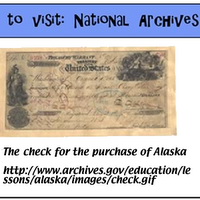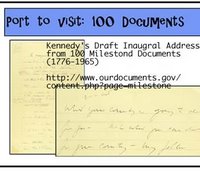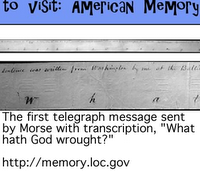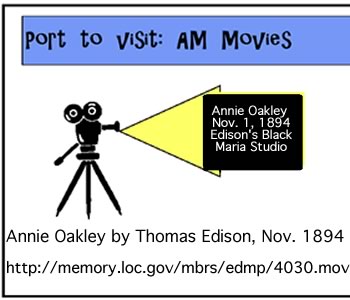 More from NECC:
More from NECC:Kathy Schrock's presentation was called, A Three-Hour Tour: Navigating Primary Source Material On the Internet. It had a sea-going theme complete with a Gilligan's Island music intro. We got the one hour tour but it was packed with so many sources it could have easily been a three hour presentation. Kathy gave two definitions of Primary sources:
"Definition 1

-actual records that have survived from the past, such as letters, photograhs, videos, and articles of clothing. Secondary sources-accounts of past created by people writing about events sometime after they happened.
 Definition 2
Definition 2Primary sources
-orginal records created at the time or after historical events occurred in the form of memoirs and oral histories
-may include letters, manuscripts, diaries, journals, newspapers, speeches, interviews, memoirs, documents produced by government agencies, photographs, audio recordings, moving pictures or video recordings, research data, and objects or artifacts."
Why should teachers use primary resources?
Kathy stated that:
" • primary sources expose students to multiple perspectives on great issues of the past and present
•Primary sources help students develop knowledge, skills , and analytical abilities"
If you want to see her presentation slides which include the links below go to http://kathyschrock.net/navigating/navigating.pdf

Kathy's Ports to Visit
• National Archives: Digital Classroom
(http://www.archives.gov/education/)
• Library of Congress American Memory Collection : Learning Page
(http://memory.loc.gov/learn/)
• National Archives: Our Documents
(http://www.ourdocuments.gov/)
• National Park Service: Treasures of our Nation
(http://www.cr.nps.gov/museum/treasures/)
• Library of Congress American Memory Collection: Inventing Entertainment
(http://memory.loc.gov/ammem/edhtml/)
Primary and Secondary Sources in the Classroom
• American Memory Collection definition
(http://lcweb2.loc.gov/ammem/ndlpedu/lessons/psources/source.html)
• University of Washington definition
(http://www.lib.washington.edu/subject/History/RUSA/)
• Why use primary resources in the classroom?
(http://learning.loc.gov/learn/lessons/fw.html)
• Selecting Primary Resources
(http://learning.loc.gov/learn/lessons/fw.html#select)
• Phyllis DiBianco. "Primary sources: clues to the past." Information Searcher. 13:3.
(http://infosearcher.typepad.com/infosearcher/articles/primarysources.pdf)
• Historical Records and Teaching
(http://www.emsc.nysed.gov/ciai/dbq/Julie.html)
Subject-Specific Sites
• Geography
o Martha B. Sharma, et.al. (2000) Greenwood Press.
Using Internet Primary Sources to Teach Critical Thinking Skills in Geography.
o Lewis and Clark Archives: The Journals
o Lewis and Clark Expedition: Voyage of Redisovery
o Rocky Mountain Life
 o America's Historical Maps
o America's Historical Mapso Topographic Maps
o Topographic Map Symbols
o Keyhole Satellite Imagery
o Microsoft's Terraserver
o Aerials Only Gallery
• Mathematics
o Evan Glazer. (2001) Greenwood Press.
Using Internet Primary Sources to Teach Critical Thinking Skills in Mathematics.
o Bath Time with Archimedes
o Hobbes' Internet Timeline
o Project Interactivate Image Tool
• Visual Arts
o Pamela J. Eyerdam. (2003) Greenwood Press.
Using Internet Primary Sources to Teach Critical Thinking Skills in Visual Arts.
o Architecture and Interior Design (LOC)
• Sciences
o Carolyn Johnson. (2003) Greenwood Press.
Using Internet Primary Sources to Teach Critical Thinking Skills in the Sciences.
o Hippocratic Oath
o Scientific Anomalies
o Alexander Graham Bell Notebooks Project
• History
o Kathleen W. Craver. (1999) Greenwood Press.
Using Internet Primary Sources to Teach Critical Thinking Skills in History.
o Photojournalism: A Record of War
o Weather on Your Birthday
o EdSitement Use Search to find topic
o What are we fighting for over there?
o Letters Written by the Pilgrims
• World Languages
o Grete Pasch, et.al. (2000) Greenwood Press.
Using Internet Primary Sources to Teach Critical Thinking Skills in World Languages.
o The State Hermitage Museum
o The Official Berlin Site German
o The Berlin Wall English
• World Literature
o Roxanne M. Kent-Drury. (2005) Greenwood Press.
Using Internet Primary Sources to Teach Critical Thinking Skills in World Literature.
• Government, Economics, and World Issues
o James M. Shiveley, et.al. (2001) Greenwood Press.
Using Internet Primary Sources to Teach Critical Thinking Skills in Government, Economics, and Contemporary World Issues.
o NARA Analysis Sheets
o WebQuests in Our Future Slide Show

More Edison Movies
Primary Source Super Sites
• American Memory Collection
(http://lcweb2.loc.gov/ammem/)
• America's Story
(http://www.americasstory.com/)
• National Archives Digital Classroom
(http://www.archives.gov/education/)
• Repositories of Primary Sources
(http://www.uidaho.edu/special-collections/Other.Repositories.html)
• Avalon Project
(http://www.yale.edu/lawweb/avalon/avalon.htm)
• Historical Census Browser
(http://fisher.lib.virginia.edu/collections/stats/histcensus/)
• USPTO Patent Applications
(http://www.uspto.gov/patft/)
• BBC Legendary Interviews
(http://www.bbc.co.uk/bbcfour/audiointerviews/)
• Feeding America
(http://digital.lib.msu.edu/projects/cookbooks/)
• NYPL Digital
(http://www.nypl.org/digital/)
• AD*Access
(http://scriptorium.lib.duke.edu/adaccess/)
• United Streaming
(http://unitedstreaming.com/)
• Technorati: Blog Search Engine
(http://technorati.com/)
• Google Blog Search
(http://blogsearch.google.com/)
• Archive.org and The Wayback Machine
(http://archive.org/)
All of the above information including the web pictures are from Kathy's presentation and her handout site http://kathyschrock.net/navigating/ Kathy spent a long time gathering and posting all these links and I thank her for sharing them. Thank You Kathy Schrock!
No comments:
Post a Comment